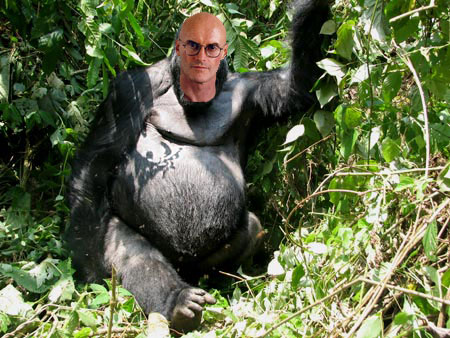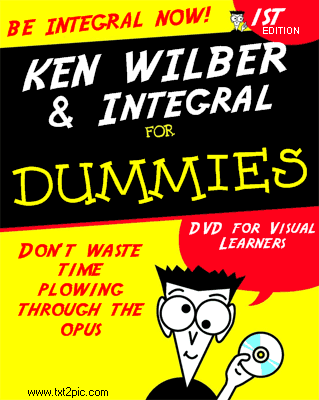
David Lane takes Ken Wilber to task, Frisky Dirt, Why Ken Wilber’s New Creationism
is Pseudo-Science, for reprising his odd views on evolution. Those views can be encapsulated in quotes from The Guru and the Pandit. Eros, Buddha, and the Spectrum of Love, from the new issue of Andrew Cohen’s magazine EnlightenmentNext.
It’s evidence of a force that is pushing against randomness in the universe.
The fact that such a thing can happen is a miracle. It’s just unbelievable.
All of this, without exception, is driven by love.
Lane’s takedown of Wilber’s ‘esotericistic’ intelligent design is okay, but let’s face it, all the varieties of intelligent design and creationism present low hanging fruit. The abstract for the article is telling:
Love is a hot topic in the world of progressive spirituality, but you haven’t heard anyone discuss it like the Guru and the Pandit. Distinguishing between love’s personal, cultural, and cosmic dimensions, they explore how this primordial force gives rise to every new emergence in the evolutionary process.
Wilber has spelled out what he means by speaking of love’s primordial force. This can be put differently without error, and on offer then is the context, a context many times more interesting than Wilber’s new age creationism.
Love works from the beginning to organize greater complexity and greater consciousness, ending up for our moment in “Ken Wilber.”
Or, ending up in the Centauric Integral, another term for “Ken Wilber.”
This developmental outcome is very ironic if you’re aware of Wilber’s antipathy toward baby boomer solipsism.
As a thinker and quasi-philosopher, Wilber’s development peaked fifteen years ago. At the time he had sketched out an interesting, even compelling, albeit rudimentary, transdisciplinary methodology. It required proponents to get down to the brass tacks of formulating a sharp critical culture.
In 2001, he told Jordan Gruber,
>E.com: In the meantime, though, the grants that people could write to I-I for, none of that’s happening?
KW: No, what’s happening right now is that one of the main things we wanted to do with the original one hundred million dollars was to get it to as many people as possible doing work in this field, the general field of integral studies and integral endeavors. That’s one of the reasons that I started Integral Institute, to act as a funding source for people doing this kind of work because the marketplace doesn’t reward truly integral studies as all. It rewards New Age approaches to it, it rewards the experiential workshop approach, as it were, it rewards the green meme and the purple meme and everything in between, but it does not reward truly integral studies.
So, the only way we’re going to get real work done in this field is, frankly, if we have funding agencies that will do it. And once the real work is done, and the research is done, and we start producing really solid texts, and presentations, and articles, and research, then we can create a market off of that. That’s going to be probably three years from now.
So, what we’ve done at Integral Institute … the biggest change in our orientation happened not because of the market, but quite independent of that, a change we would have made whether the market went up or down. And that is, we went from being a kind of community of some four hundred founding members to focusing more on producing what we call “integral product,” actual books, texts, academic material in each of the ten branches. So we’re working on books in, for example, What is Integral Politics? What is Integral Business? Integral Medicine? Integral Law? Because what we found was that there were no really strong statements about an integral approach to any of these fields.
E.com: Which is one of the reasons academia can ignore it completely.
KW: It can ignore it completely, and the other things we found is that most people with very very good intentions would simply take what they’re doing and call it integral when it really wasn’t. They were leaving out certain aspects of the human condition that ought not to be left out. We could demonstrate that to them, and they would say, “OK, I guess what I’m doing is not integral.”
So before we can build community, or create a market, or have a web presence, or have conferences, we have to produce specific texts in each of these ten branches, put together by one of our core teams of recognized scholars and researchers, saying “This is our best shot as an opening statement about what integral business is, integral politics, integral education, integral medicine, integral law, integral psychology, integral spirituality, and so on.”
Actually, what happened was this was inverted. Wilber created a community, a web presence, conferences, and, crucially, a market. Wilber’s Integral has been regressing ever since. Only The Integral Leadership Review, (itself mostly off the Wilberian reservation,) regularly publishes something like scholarship. Elsewhere there isn’t a body of Integral scholarship in those other nine branches, where the scholarship works to, as the Wilberian principle goes, keep the good and throw out the bad. So, without having enabled a keen critical culture to negotiate disciplinary fields using a robust and sophisticated Integral criteria, the Integral methodology was sunk.
Wilber’s creationism is interesting because its context is not Integral biology, but rather its context (and purpose) is the yoking of Wilber’s product lines to the biggest, most fantastic, view of that which can be the reward for buying Wilber’s spiritual technologies. This value-added idea is simple:
Love works from the beginning to organize greater complexity and greater consciousness, ending up for our moment in your ability to realize your cosmic integral love-vitalized high consciousness nature.
One has to buy a ticket, or otherwise pony up.
As for biology and science, Wilber has time and time again, in interviews with Larry Dossy, and other new age thought leaders, proposed that what is bad about science, methodological materialism, needs to be reformed and revolutionized, and, he’s implied, transformed into something altogether more ‘integral-mystical.’ (Magical!) Needless to say there aren’t any cogent Integral philosophers of science. Nor is there–as far as I know–any scholarly Integral biology, Integral physics, Integral anthropology, etc.. Also, the varieties of integral-like interdisciplinary and transdisciplinary scholarship found in some fields is not under review by Integral scholars.
No, there is only the facile spiritualizing of the Wilberian spiritual technology put up for sale. ‘Adeptitude’ has taken over; sadly. The strange, anti-intellectual case is that as much as this high-minded technology harps on getting right with The Shadow, science itself is smack dab in the middle of Wilber’s own shadow. I suspect love is stuck there too because the self-agrandizing, primordial move is too easy, compared, say, to the necessarily unsparing, perspective of Rilke.
To reconfigure Carl Jung’s famous insight,
…where power marketing predominates, love is lacking.

